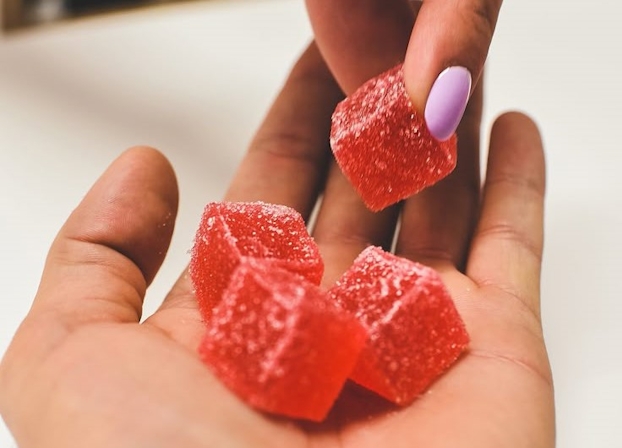
Vitalii khodzinskyi / Unsplash
THC vs. CBD: The Real Differences Explained for Everyday Users
Same source, very different effects. Learn the key differences between THC and CBD, and how to choose the best one for your needs.
What is the difference between THC and CBD? These two cannabis-derived compounds from the Cannabis sativa plant may come from the same source, but they interact with the body in very different ways. If you’re comparing CBD vs THC effects, weighing THC vs. CBD for chronic pain or focus, or curious about how to use both THC and CBD together, this guide will help you make sense of it all.
Core Differences Between THC and CBD

Roxana Gonzalez / Shutterstock
While both cannabinoids are active ingredients derived from the cannabis plant, their properties and effects vary widely. Here’s a breakdown of the major differences:
Psychoactivity
- THC causes psychoactive effects; it’s the compound responsible for the cannabis “high.”
- CBD is non-intoxicating and may even reduce THC’s intensity when used together.
Legal Status
- Cannabis with more than 0.3% delta-9 THC remains illegal according to the federal government, though medical marijuana and recreational use are legal in many states.
- CBD, when derived from “hemp,” is federally legal but still subject to FDA regulation in CBD products like supplements or food.
Medical Uses
- THC is often used for chronic pain, PTSD symptoms, muscle stiffness, nausea, and appetite loss.
- CBD is effective for seizures (including severe forms), inflammation, and treating anxiety and sleep disorders, and is widely used in medical cannabis formulations for non-intoxicating relief.
Side Effects
- THC may cause dry mouth, dizziness, or impaired motor coordination, especially at higher doses.
- CBD is generally well tolerated with mild, rare adverse effects, even in clinical trials.
Drug Testing
- THC is detectable in most drug screenings, including workplace tests, due to how long THC metabolites remain in the body.
- CBD use may still result in a positive test if cannabis products contain trace levels of THC.
THC vs. CBD: Mental and Physical Effects Compared

Crystalweed
Both cannabinoids interact with the endocannabinoid system (ECS), a regulatory system that influences mood, pain, sleep, immune response, and other physiological processes. Their differing actions on cannabinoid receptors and other molecular targets explain why they produce such different effects.
Mental
THC binds directly to CB1 receptors, primarily located in the brain and central nervous system, which creates the psychoactive properties associated with cannabis. This connection can alter how we experience things, changing our mood, perception, and the clarity of our thoughts. Some people feel relaxed, even creatively inspired, with small amounts. Others might feel overwhelmed, especially with higher doses, leading to anxiety, uneasiness, or mental fog. Sensitivity to THC varies a lot from person to person.
Consuming CBD doesn’t work the same way THC does. Instead of attaching directly to the CB1 receptors, it affects several other systems in the body, like serotonin signaling or TRPV1, which is involved in pain and inflammation. Researchers are still figuring out the whole picture, but that broader influence might help explain why CBD can take the edge off anxiety or even mellow out some of THC’s stronger effects when they’re used together.

Herb
Addiction Potential
THC’s impact on brain reward systems means it does carry a risk of dependence. Approximately 1 in 10 cannabis consumers may develop cannabis use disorder, particularly with frequent or high-dose use of THC products. As with other forms of substance use, prolonged activation of CB1 receptors can reinforce habitual consumption, leading to potential harms like cravings, withdrawal symptoms, and difficulty cutting back.
So far, there’s no evidence that CBD causes addiction or leads to abuse, even when people take fairly high doses. Researchers are looking at how it might help people recovering from substance use, including nicotine and opioid dependence. Because it doesn’t cause a high and rarely leads to side effects, some clinicians see it as a promising option for people exploring more integrative, less disruptive ways to support recovery.
Physical
THC has well-documented therapeutic properties for managing chronic pain, appetite loss, nausea, and muscle stiffness, especially in patients with multiple sclerosis or undergoing chemotherapy. Ongoing randomized clinical trials continue to evaluate its role in treating a range of medical conditions. However, physical side effects like dry mouth, dizziness, or coordination issues can occur, particularly with high-potency cannabis products or extracts.
CBD’s anti-inflammatory action may help support balance in the immune system, particularly for individuals managing chronic conditions. Its cannabis-derived compounds may help regulate physiological responses without sedation or impairment, making it suitable for daytime use or long-term wellness routines. Because CBD lacks the intoxicating effects of THC, many people use CBD-containing products regularly without concerns about building up a cannabis tolerance or a “high.”
Choosing Between THC and CBD: A Decision Guide for Everyday Users

Canvast Supply
Choosing between THC and CBD isn’t only about whether you want to feel high. It often comes down to what kind of relief you’re looking for, like help with sleep, pain, or staying focused, and how your body responds. Some people stick with one or the other, but many find that using them together actually works better.
Which Is Better For…
Pain Relief
When it comes to managing moderate or hard-to-treat pain, especially nerve-related pain, THC often does the job more effectively than other options. It works by interacting with CB1 receptors in the brain and other pathways that help dial down pain signals. On the other hand, CBD might be a better fit for ongoing inflammatory pain or for folks who want relief without feeling high. Many people end up using both, and use balanced THC to CBD ratios, such as 1:1, which can provide a middle ground that works well for daily use.
Sleep
THC can help people fall asleep faster, especially in the short term; however, it may reduce REM sleep and cause grogginess for some individuals. CBD may not act as a sedative, but it appears to improve sleep quality over time, particularly when anxiety or chronic stress interferes with rest. Some people use CBD during the day and a small dose of THC at night for a balanced approach to sleep support.
Socializing
THC can make social settings feel more relaxed, talkative, or amusing, especially when consumed in low doses. Strain choice also plays a role; some strains may make socializing feel easier compared to others. However, in some users or at higher doses, it can cause overthinking or anxiety-like behavior. CBD may be better suited for individuals with social anxiety, as it can ease tension without impairing mental clarity or causing psychoactive effects.
Focus & Productivity
If you’re trying to stay clearheaded and productive during the day, CBD tends to be the better choice. It can help alleviate stress or mental clutter without making you feel foggy or tired. Some people find it easier to concentrate on tasks or stay grounded when using CBD regularly. THC, depending on the dose and strain, can sometimes interfere with focus or lower motivation; however, some people report that microdosing cannabis can help them enter a more focused, creative, or relaxed state of mind. However, for most, CBD is the more dependable option for work, study, or staying focused.
Recovery
Recovery, whether from a workout, long day, or ongoing stress, is where combining THC and CBD often makes the most sense. THC can help alleviate muscle soreness, stimulate your appetite, and promote relaxation. CBD may help control inflammation and promote mental calm. Used together, they can cover more ground than either one on its own. Some people use a little THC after activity and keep CBD in their daily routine for ongoing support, reporting significant improvements in soreness, stress, and rest.
Together or Separate?

The decision to use CBD and THC together or separately depends on your goals, sensitivities, and the specific cannabis products available to you. Many formulations on the market today include a combination of both cannabinoids to take advantage of the entourage effect, a synergistic interaction between cannabis compounds that may enhance benefits and reduce adverse effects.
A lot of people find that taking THC and CBD together works better, especially when they’re dealing with more layered issues like pain that won’t let up, sleep that’s hard to come by, or lingering stress from PTSD. Products with a balanced ratio, such as a 1:1 tincture, can ease the body without overwhelming the mind. For some, a little THC alongside more CBD strikes just the right balance between feeling better and staying clear.
That said, there are definitely times when keeping them separate is the better move. If you’re worried about drug tests, don’t tolerate THC well, or want something that won’t cloud your head, sticking with CBD might be the smarter call. Some folks start there and slowly bring in THC to see what their system can handle and how it affects them.
Final Thoughts

Herb
Both CBD and THC come from the cannabis plant, but they don’t act the same once they’re in your body. Each one interacts differently with the endocannabinoid system, which plays a big role in how we feel, rest, and respond to stress or pain. That’s why it helps to know how they work, especially if you’re using cannabis to deal with chronic pain, anxiety, or something like post-traumatic stress disorder (PTSD).
Ongoing research continues to shed light on the therapeutic potential of these cannabinoids. Whether you prefer to use them separately or together, knowing what each compound does and how it aligns with your personal health goals can help you make smarter, safer choices. Legal access, local policy, and formulation also matter, so staying informed is just as important as choosing the right product.
Herb Recommended Products:
READ MORE










